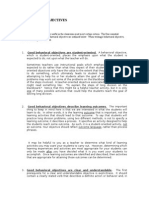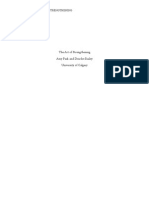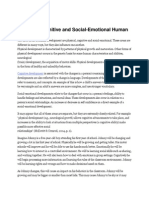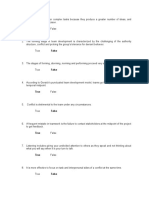Final Essay
Final Essay
Uploaded by
api-311773794Copyright:
Available Formats
Final Essay
Final Essay
Uploaded by
api-311773794Original Title
Copyright
Available Formats
Share this document
Did you find this document useful?
Is this content inappropriate?
Copyright:
Available Formats
Final Essay
Final Essay
Uploaded by
api-311773794Copyright:
Available Formats
Hannah Knight - 110165711
Introduction
Managing learning environments requires the understanding of many
skills and strategies to ensure that that the students are learning in a safe
and secure environment. It is firstly important to address the core
principles that guide the decisions and actions taken in a classroom
context. The main idea understood throughout the guiding principles is
that of dignity, which Charles states, refers to respect for life and self
(1999, p. 202). An approach to promoting productive behaviours can be
examined through Williams (2013) 4S framework, which encompasses the
role of systems, setting, student and self. These dimensions incorporate a
number of strategies that could be used to prevent unproductive
behaviour and each contribute to the overall effect of a productive
learning environment. Understanding intervention and approaches to
managing unproductive behaviours in the classroom is considered through
a range of technique such as non-verbal techniques including proximity
and body gestures and the use of I-messaging, which are explored further
in this paper. Williams ICDAR framework for low intervention is also
explored in terms of the steps to take when confronted by misbehaviour
and ways to resolve this in a ways that promotes dignity.
Guiding Principles
There are a number of underlying principles that support the actions and
decisions I make as a teacher. The main principle to consider when
creating a classroom environment is to ensure all children are treated and
considered with respect and their dignity is upheld. Maintaining student
dignity underlies all actions and decisions I make as a teacher. Charles
states to treat students with dignity is to respect them as individuals, to
be concerned about their needs and understanding of their viewpoints
(1999, p. 205). I interpret this definition as the need to create a learning
environment that offers hope to students throughout their learning
(Charles, 1999). Additional principles that are also considered include
ensuring a predictable learning environment where the students are
aware of the expectations in and out of the classroom. This requires
different techniques to scaffold the students in the creation of these
norms and to model the rules and procedures. This sense of respect can
be understood through Cothran, Kulinna and Garrahy who discuss the
need for students to feel as if they are being treated as equals to teachers
and adults (2002). Another key principle to consider when making
decisions is based around the need to create healthy and positive
relationships with others. Kohn allows for the understanding that creating
a community ensures that the students and teacher feel cared about and
are encouraged to care about each other (2006).
Prevention
Setting
Hannah Knight - 110165711
The idea of prevention strategies can be understood through Williams 4S
conceptual framework of classroom management (2013, p. 6). The
intersecting idea of setting can be considered in terms of the ways in
which this can promote productive behaviour. Williams discusses the
importance of arrangement skills in establishing a productive learning
environment and the need to consider the topography of the learning
environment, resources, interaction, movement and space (TRIMS) (2013,
p. 8). The acronym TRIMS, allows for an understanding of the ideas to
consider when organising the physical setting of the classroom. The
specific considerations would include the seating layout within the
classroom and also the seating plan of the student, the monitoring and
supervision, the location of the resources and the planning of the
additional physical requirements of the classroom (Williams, 2013). The
physical setting should be considered carefully to ensure that
unproductive behaviour is kept at a minimum within the classroom and
simple ideas and considerations around the placement of tables to create
a safe and welcoming environment and ensure students can access the
classroom and resources at all times reduces disruptions and increase
productive behaviours.
Systems
Within Williams (2013) 4s conceptual framework the idea of systems is a
key element to consider when identifying strategies to prevent
unproductive behaviours. Systems within a classroom can be recognised
as the administrative and management systems that are integrated within
the classroom community (Williams, 2013). The need to create an
environment that has clear rules and procedures that are understood by
students is particularly important in preventing unproductive behaviour.
This can be considered through McDonald who states, the aim of class
routines and procedures is to enhance the learning environment. They are
meant to increase academic engagement by lessening opportunities for
disruption and off task behaviour (2013, p. 140). Routines around how
students enter the room, where they can get materials/resources from,
gaining their attention, what to do when they finish their work and many
other ideas can ensure lessons and the day runs smoothly. It can also be
understood that having the routines and procedures in place allows for
self-regulation of the students, which increases their sense of equality
within the classroom.
Rules can be understood through Charles who states rules help specify
behaviours that are acceptable, or unacceptable, in the classroom. When
carefully planned, rules help meet everyone's needs (1999, p. 206).
Students must have the opportunity to buy in and assume responsibility
in order to allow for the students to have ownership over the rules as well
as the consequences of their actions (McDonald, 2013 and Good and
Brophy, 2008). The way in which students can be incorporated in the
establishment of classroom rules would be in terms of a class meeting to
discuss and outline the need for rules as well as the consequences of not
following them. Ensuring students play a part in creating the rules and
Hannah Knight - 110165711
routines we all must abide by creates an environment in which students
are treated as equals and have a say in their own learning environment.
The respect shared further instils a sense of community within the
classroom as students feel heard and a necessary part in the classroom
management, this in turn preserves their dignity as is respects their life
and acknowledges their ideas and needs and is a fundamental prevention
technique to ensure students are aware of the expectations within the
classroom.
Student
The emphasis of the student dimension in the 4S framework outlined by
Williams focuses on the ways in which students interact with one another
and the ways this can promote a productive learning environment.
Watkins (2005) discusses the required ingredients for a community to
succeed and include agency, a sense of being part of the collective,
cohesion and an understanding of diversity and the need to embrace this.
This can be further understood through specific characteristics of a
classroom community outlined by Sapon-Shevin (2010). In order for
students to take risks in the community all students must support a safe
and secure environment in which all students can feel free to take risks
with their learning, ask for help and support and express themselves
freely (Sapon-Shevin, 2010). This can prevent unproductive behaviour as
students can share the fact they dont understand, as they know they will
be met with support instead of humiliation (Sapon-Shevin, 2010). Students
will have many opportunities to work together in small and large groups,
this creates a mutual liking in the classroom as defined by Sapon-Shevin
as an opportunity for students to become friends with one another as the
classroom is structured so that students learn to see and appreciate their
classmates (2010, p. 23). This creates a positive learning environment for
students and ensures productive behaviours as it gives students a sense
of belonging and that they are needed for the classroom to run they
therefore will not want to let each other down.
Self
The role of self within Williamss 4S framework is one of the most crucial
aspects to consider when promoting productive behaviour. It must first be
understood that the 4S framework is an interconnected model in which
the 4S overlap and a look at self must involve the setting, systems and
students also. Kounin (1970 cited in Good and Brophy, 2008) discusses
the idea that effective teachers are able to minimise the frequency of
disruptions and resolve minor unproductive behaviours using a few key
strategies. These include withitness which involves regularly monitoring
the classroom and ensuring the students know the teacher is aware of
their behaviour allows for problems to be nipped in the bud before they
escalate. Overlapping where teachers must do more than one thing at a
time. Group alerting where a teacher must have strategies to alert the
group to maintain or re-establish attention, which can be done through a
random selection of students to be called on. Accountability ensures that
students are responsible for paying attention and the last idea is variety
Hannah Knight - 110165711
and challenge where the work provided must be both familiar for students
to complete successfully yet challenging and varied to support their
enthusiasm (Kounin, 1970 cited in Good and Brophy, 2008).
Intervention
There are a number of ways in which a teacher can manage unproductive
behaviour however the disruptive influence of the teachers intervention
should not be greater than the disruption it is intended to reduce (Jones
and Jones, 2010). One of the main elements to managing misbehaviour is
through the use of I-messaging. This can be defined as a statement that
emphasise your position by describing the problem observed and how this
made you feel and why, the statement avoids using accusatory you and
also allows for the user to take responsibility by using personal pronouns
(Lyons, Ford and Slee, 2014, Jones and Jones, 2010 and Larrivee, 2008).
Another important aspect of managing unproductive behaviours is
through using non-verbal tools such as facial expressions, eye contact,
gestures and also proximity where you simply move closer to the student
(Lyons, Ford and Slee, 2014 and Jones and Jones 2010). In order to
deescalate a situation Larrivee (2008) and Jones & Jones (2010) suggest
the use of humour to defuse any angry feelings that are associated with
the conflict and to increase interest and promote engagement. Another
key element to managing unproductive behaviour is through assertion,
defined by Larrivee as expressing your needs, thoughts, or feelings
clearly and directly without judging, dictating or threatening (2008, p.
331). This is an important aspect of intervention due to the fact that being
assertive is to confront the situation or conflict and can generate positive
feelings for those involved, it maintains the self respect of both parties
and feelings of resentment, anger and guilt are avoided (Larrivee, 2008).
Williams (2013) ICDAR model is an approach of low prevention that can
be implemented within the classroom to resolve unproductive behaviour.
The model begins with the need to identify the issue and be aware of the
classroom dynamics. This can be done through withitness and rules and
routines being put in place. The second stage in this model is to consider
the issue in terms of the magnitude, frequency, significance or disruption
factor (Williams, 2013). You must then decide to either take action or
tactfully ignore or diffuse the situation. If action is required the least
disruptive level of intervention must be considered and can include nonverbal actions such as face and hand gestures and proximity control,
general verbals such as changes in volume and speed, task verbals such
as asking if the child needs help or checking their progress and
transaction verbals which includes questioning with specific names. These
four low level interventions allow for the teacher to maintain the childs
dignity and treat them in a respectful manner while addressing the
unproductive behaviour. The final stage in the model is to reinforce with
positive comments and invoke a consequence if necessary (Williams,
2013). It must be remembered that the focus should remain on the
Hannah Knight - 110165711
behaviour and not on the person and the ultimate intention is to reengage
them with the task (Williams, 2013).
Conclusion
Through examining techniques for the prevention of unproductive
behaviours in the classroom using Williams 4S framework, it can be
understood the ways in which setting, systems, student and self all
contribute to the management of a learning environment. Especially in
terms of the physical layout of desks and students, the rules and
procedures that are put in place, the building of a sense of community and
the ways in which a teacher (self) must use techniques such as withitness,
accountability and de-escalation practises in order to control and manage
an environment. The role of intervention in terms of managing
unproductive behaviours is understood through a number of strategies
and skills and must be at a low level of disruption in order to uphold the
dignity of the child. This includes using I-messages, humour and also
assertiveness. Williams (2013) ICDAR model offers an understanding of
the steps that can be taken in order to resolve the conflict. These
techniques can be understood to create and maintain student dignity and
to increase the respect and positive attitudes held by all. If a students
dignity is upheld and they are treated with respect though the prevention
and intervention strategies this in turn creates a learning environment
that promotes productive behaviour.
Reference
Charles, C. M 1999 Richard Curwin and Allen Mendler's discipline with
dignity. Building classroom discipline, New York: Longman.
Cothran, D. J, Kulinna, P & Garrahy, D.A 2003, This is kind of giving a
secret away...: students' perspectives on effective class management,
Teaching and Teacher Education, Vol. 19, pp. 435-444.
Good, T. L., & Brophy, J. E. (2008). Chapter 3 Management 1: Preventing
problems. Looking in classrooms (10th ed.). Boston, MA: Pearson/Allyn and
Bacon.
Jones, V. F & Jones, L. S 2010, Chapter 8 Responding to violations of rules
and procedures, Comprehensive classroom management: Creating
communities of support and solving problems (9th ed.), Upper Saddle, NJ:
Merrill.
Hannah Knight - 110165711
Kohn, A 2006, The nature of children. Beyond discipline: From compliance
to community Alexandria, VA: Association for Supervision and Curriculum
Development.
Larrivee, B 2009, Conflict and stress management strategies. Authentic
classroom management, Upper Saddle River, NJ: Pearson.
Lyons G, Ford M & Arthur-Kelly, M 2011, Chapter 3 Relationships and
communication Classroom management: creating positive learning
environments (3rd ed.), South Melbourne, Vic: Cengage Learning.
McDonald, T 2013, Proactive Teacher Behaviours. Classroom
management: Engaging students in learning South Melbourne, VIC: Oxford
University Press.
Sapon-Shevin, M 2010, Schools as communities. Because we can change
the world: A practical guide to building cooperative, inclusive classroom
communities, 2nd ed., pp. 21-44, Thousand Oaks, CA: Corwin.
Watkins, C 2005, Chapter 4 Classrooms as learning communities: A
Review of Research, Classrooms as learning communities: What's in it for
schools?, London and New York: Routledge.
Williams, D 2012, Background Basics, Adelaide: University of South
Australia.
You might also like
- Lesson-Plan-in-ENGLISH-3-Common and Proper NounsDocument4 pagesLesson-Plan-in-ENGLISH-3-Common and Proper NounsJevreel De Vera100% (1)
- 2nd Generation of Filipino ArchitectsDocument14 pages2nd Generation of Filipino ArchitectsJAXXNo ratings yet
- 5 Things To Become ColdDocument15 pages5 Things To Become ColdBet100% (3)
- ELPT - Intensive CourseDocument41 pagesELPT - Intensive CourseYuan faiha100% (2)
- Discussion Forum Unit 5Document2 pagesDiscussion Forum Unit 5studyjunkyNo ratings yet
- Standard 4Document7 pagesStandard 4api-525868537No ratings yet
- Tpack Lesson PlanDocument5 pagesTpack Lesson Planapi-350281802No ratings yet
- The 4s Conceptual FrameworkDocument1 pageThe 4s Conceptual Frameworkapi-361327264No ratings yet
- DTL Assessment 1 - FinalDocument8 pagesDTL Assessment 1 - Finalapi-505912741No ratings yet
- World Englishes and Culture Wars by Braj KachruDocument3 pagesWorld Englishes and Culture Wars by Braj KachruClaudia IlhéusNo ratings yet
- Assignment 2Document6 pagesAssignment 2api-436147740No ratings yet
- EDU4230 - Classroom Management Plan: (Charles, 1992.)Document4 pagesEDU4230 - Classroom Management Plan: (Charles, 1992.)Dave SnorlaxNo ratings yet
- Mle Essay - Emma DeboerDocument11 pagesMle Essay - Emma Deboerapi-333348168100% (2)
- Eea202 Assess 1Document11 pagesEea202 Assess 1api-354631612No ratings yet
- Classroom Management Week 1Document8 pagesClassroom Management Week 1Andreea PopNo ratings yet
- Mle EssayDocument9 pagesMle Essayapi-350584888No ratings yet
- Classroom Management PlanDocument5 pagesClassroom Management Planapi-331573623No ratings yet
- Classroom Management Plan Template1Document8 pagesClassroom Management Plan Template1api-319663115No ratings yet
- Behavioral ObjectivesDocument4 pagesBehavioral ObjectivesDilruk GallageNo ratings yet
- Assessment 1 102082Document11 pagesAssessment 1 102082api-368764995No ratings yet
- Classroom Management Summary JasminDocument9 pagesClassroom Management Summary JasmintigagaganiganigaiNo ratings yet
- Classroom Management Output FinalDocument3 pagesClassroom Management Output FinalIron FeathersNo ratings yet
- EDU30006-A1-Humanities Portfolio-Maddison Edebohls-102906427Document11 pagesEDU30006-A1-Humanities Portfolio-Maddison Edebohls-102906427Maddie EdebohlsNo ratings yet
- 5010 Unit 4Document6 pages5010 Unit 4Teacher Andri100% (1)
- Assessment 1Document13 pagesAssessment 1api-297389221100% (1)
- Kohlberg's Theory of Moral DevelopmentDocument8 pagesKohlberg's Theory of Moral DevelopmentNavin MehtaNo ratings yet
- Scaffolding For ReasoningDocument5 pagesScaffolding For ReasoningMichael KingNo ratings yet
- Assignment Behaviourist PrinciplesDocument11 pagesAssignment Behaviourist PrinciplesSyamimi Zolkepli0% (1)
- EDUC 5410 UNIT 6 Discussion Assignment PERSONALITY AND SOCIAL DEVELOPMENT PART IDocument3 pagesEDUC 5410 UNIT 6 Discussion Assignment PERSONALITY AND SOCIAL DEVELOPMENT PART IAni Jones100% (1)
- Adolescent Development and TeachingDocument1 pageAdolescent Development and Teachingapi-461572829No ratings yet
- INTRODUCTIONDocument18 pagesINTRODUCTIONRmaNo ratings yet
- Theory Learning EssayDocument5 pagesTheory Learning Essayapi-298174816No ratings yet
- Thought Paper 2Document4 pagesThought Paper 2api-236492991No ratings yet
- Learning Theories: Behaviorism, Cognitivism, ConstructivismDocument7 pagesLearning Theories: Behaviorism, Cognitivism, ConstructivismJb-rn Cacho BasanezNo ratings yet
- Classroom Management SystemDocument7 pagesClassroom Management Systemajextope100% (1)
- EDUC 4206: Professional Experience 4: Teacher As Inquirer The ProposalDocument22 pagesEDUC 4206: Professional Experience 4: Teacher As Inquirer The Proposalapi-464562811No ratings yet
- Teaching and Learning PhilosophyDocument2 pagesTeaching and Learning PhilosophyNicole WalstromNo ratings yet
- Part One: Student Profile and UDL ImplementationDocument11 pagesPart One: Student Profile and UDL Implementationapi-357537784No ratings yet
- Classroom ManagementDocument42 pagesClassroom Managementapi-489134454No ratings yet
- Constructivism and Learning in ScienceDocument9 pagesConstructivism and Learning in ScienceHilma SuryaniNo ratings yet
- Conversational StyleDocument9 pagesConversational StyleFerdinand Guillermo0% (2)
- Assertive in ClassroomDocument5 pagesAssertive in ClassroomAtiqa NurNo ratings yet
- Edtpa Lesson Plan Honey BeeDocument2 pagesEdtpa Lesson Plan Honey Beeapi-253338725No ratings yet
- Final AssessmentDocument27 pagesFinal Assessmentapi-307613003No ratings yet
- EDUC 5410 Unit 1 Discussion February 2022Document4 pagesEDUC 5410 Unit 1 Discussion February 2022us n100% (1)
- ECE Hauora Report 2022Document45 pagesECE Hauora Report 2022Stuff NewsroomNo ratings yet
- rtl1 - Engagement With An Educational Issue FinalisedDocument10 pagesrtl1 - Engagement With An Educational Issue Finalisedapi-408480165No ratings yet
- Positive Learning Environments and Classroom Behavioural TheoryDocument11 pagesPositive Learning Environments and Classroom Behavioural Theoryapi-459576779No ratings yet
- Arranging The Physical Environment of The Classroom To Support Teaching-LearningDocument5 pagesArranging The Physical Environment of The Classroom To Support Teaching-LearningMarwan Al-tayarNo ratings yet
- On Teacher Collaboration - The Art of StrengtheningDocument16 pagesOn Teacher Collaboration - The Art of StrengtheningDeirdre BaileyNo ratings yet
- Assessment 1 - Why Do Children MisbehaveDocument14 pagesAssessment 1 - Why Do Children Misbehaveapi-333990095No ratings yet
- Applying The Kemp Id Model and Constructivist Learning Theory To Online InstructionDocument14 pagesApplying The Kemp Id Model and Constructivist Learning Theory To Online Instructionapi-273790976No ratings yet
- Physical, Cognitive and Social-Emotional Human DevelopmentDocument2 pagesPhysical, Cognitive and Social-Emotional Human DevelopmentsanamaqboolNo ratings yet
- Unit 1 (EDUC 5410) WADocument6 pagesUnit 1 (EDUC 5410) WAFRANCISCO ANTONIO DE LEON100% (1)
- Classroom ManagementDocument5 pagesClassroom ManagementSudhiksha SurmughiNo ratings yet
- Hodson (2010) Science Education As A Call To Action - Sem MarcacoesDocument11 pagesHodson (2010) Science Education As A Call To Action - Sem MarcacoesCatalina ÁvilaNo ratings yet
- U7 Wa 5410Document5 pagesU7 Wa 5410TomNo ratings yet
- Philosophy of Classroom ManagmentDocument2 pagesPhilosophy of Classroom Managmentapi-530896223No ratings yet
- EDUC 5220 Unit - 1 Writing Assignment APADocument5 pagesEDUC 5220 Unit - 1 Writing Assignment APAGreshma Momaya100% (1)
- Special Education and Inclusion Abi WoldhuisDocument6 pagesSpecial Education and Inclusion Abi WoldhuisabiwoldhuisNo ratings yet
- Reflections - FNDocument5 pagesReflections - FNapi-324326813No ratings yet
- Educ 5271 Wa6Document6 pagesEduc 5271 Wa6Viktoriya ZafirovaNo ratings yet
- Exemplary Classroom Questioning: Practices to Promote Thinking and LearningFrom EverandExemplary Classroom Questioning: Practices to Promote Thinking and LearningRating: 5 out of 5 stars5/5 (1)
- Final EssayDocument6 pagesFinal Essayapi-311773794No ratings yet
- Maths 3 Week 3Document3 pagesMaths 3 Week 3api-311773794No ratings yet
- Maths 1 - 3 2Document3 pagesMaths 1 - 3 2api-311773794No ratings yet
- Lesson Plan - 2 1Document20 pagesLesson Plan - 2 1api-311773794No ratings yet
- Lesson Plan - 2 1Document20 pagesLesson Plan - 2 1api-311773794No ratings yet
- Unit Plan-2 2Document17 pagesUnit Plan-2 2api-311773794No ratings yet
- Scopus - Sources - Linguistic Q2Document9 pagesScopus - Sources - Linguistic Q2noraNo ratings yet
- Ead 530 Supervising and Coaching Special Education TeachersDocument6 pagesEad 530 Supervising and Coaching Special Education Teachersapi-671417127No ratings yet
- Ieo Sample Paper Class-10Document2 pagesIeo Sample Paper Class-10ANANYA CHUGHNo ratings yet
- Questions On Lead Small Teams AbenetDocument4 pagesQuestions On Lead Small Teams AbenetAnonymous oYSGVTPsaP75% (4)
- Sample Teacher Improvement Plan 2012Document2 pagesSample Teacher Improvement Plan 2012NoordinaBadarudinNo ratings yet
- DL Lab Manual 2022-23Document34 pagesDL Lab Manual 2022-23Shivam ShindeNo ratings yet
- FDRN ReviewerDocument12 pagesFDRN ReviewerKate Audrey GernaleNo ratings yet
- DevTest - Architecture Best Practices - Use Case#2Document18 pagesDevTest - Architecture Best Practices - Use Case#2Sumit KumarNo ratings yet
- Sapienza University of Rome - Dept. of Dynamic and Clinical Psychology ° LUMSA University of Rome - Dept. of Human ScienceDocument15 pagesSapienza University of Rome - Dept. of Dynamic and Clinical Psychology ° LUMSA University of Rome - Dept. of Human ScienceramiromarquesNo ratings yet
- Dlp-English 8 - Feb. 23, 2023Document6 pagesDlp-English 8 - Feb. 23, 2023Kerwin Santiago ZamoraNo ratings yet
- Onloom Twist Impart For Multi Pick Insertion in Airjet LoomDocument32 pagesOnloom Twist Impart For Multi Pick Insertion in Airjet LoommalarmathimuniasamyNo ratings yet
- Resume SampleDocument2 pagesResume SampleAbinav TrueLoverNo ratings yet
- I. Pro-Japanese Filipinos Who Sided With Japan During World War IIDocument3 pagesI. Pro-Japanese Filipinos Who Sided With Japan During World War IIhanbinNo ratings yet
- Management OnboardingDocument4 pagesManagement OnboardingHelga BalintNo ratings yet
- BBC Homework GamesDocument5 pagesBBC Homework Gameserr64wxh100% (1)
- Kitty Balazadeh Josefin Hansson Bachelor Thesi PDFDocument52 pagesKitty Balazadeh Josefin Hansson Bachelor Thesi PDFAdri EspinilloNo ratings yet
- Disability and Mental Health EssayDocument12 pagesDisability and Mental Health EssayNicholas MartinNo ratings yet
- HierarchicalClusteringASurvey - Published7 3 9 871Document5 pagesHierarchicalClusteringASurvey - Published7 3 9 871thaneatharran santharasekaranNo ratings yet
- C. Underline The Abstract Nouns in The Following SentencesDocument8 pagesC. Underline The Abstract Nouns in The Following Sentencessouhitya debsharmaNo ratings yet
- Psychosocial AestheticsDocument17 pagesPsychosocial AestheticsDavid CastroNo ratings yet
- Ielts Speaking SportsDocument6 pagesIelts Speaking SportsHuy BùiNo ratings yet
- A Review of The Movie 3 IdiotsDocument2 pagesA Review of The Movie 3 IdiotsST2MB 12No ratings yet
- Q2.COT - Identify Family MembersDocument10 pagesQ2.COT - Identify Family MembersPearl Obliga100% (1)
- Infromal AssessmentDocument4 pagesInfromal Assessmenthind.rifiNo ratings yet
- Autonomy and Participative Processes in Emotional EducationDocument19 pagesAutonomy and Participative Processes in Emotional EducationIria KBNo ratings yet






























































































